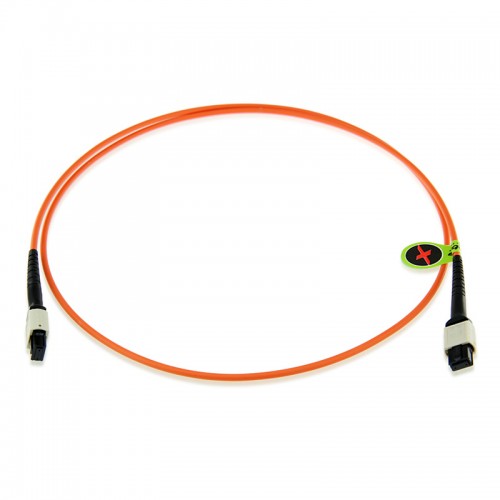0
24 Fiber Multimode OM1 MPO Patch Cable
MPO Gender
MPOs are classified by the guide pins on the end of the connector, and require 1 male and 1 female to mate properly. MPO connectors use a “barrel sleeve” adapter that simply holds one male and one female MPO “plug” together. The male guide pins fit into the female holes to ensure precise fiber alignment. Attempting to mate two female connectors will result in a seemingly secure connection, but with extremely high loss, and attempting to mate two male connectors will most likely damage one or both connectors due to the guide pins clashing.
Transceivers and cassettes come with the sleeve adapter built in, and the industry standard is a male conection on the inside. Therefore, the standard for cables is female to female. This changes, however, when you need to extend a cable or connect two cables. You will then need a male to female cable plus adapter. If you’re designing a multi-ferrule MPO trunk backbone cable, you might consider making this male to male, then patching to your hardware with female to female cables. We offer all combinations of genders, so contact us with your needs and we will be able to customize these for you.
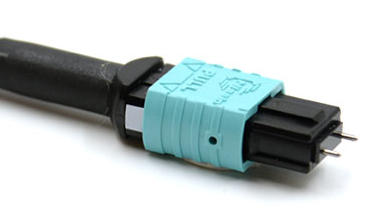 | 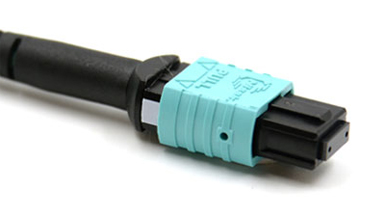 |
| MPO Male with Pins | MPO Female without Pins |
| Cassettes | Male Port |
| Transceivers | Male Port |
| Patch Cables | Female to Female |
| Extender Cables | Male to Female |
| Trunk Cables | Male to Male (Custom Mix) |
MPO Polarity
There is typically only 1 common polarity method in the construction of 24-fiber MPO/MTP style patchcords – Straight. The schematic below attempts to visually show how this polarity method is configured. Custom configurations are also available upon request.
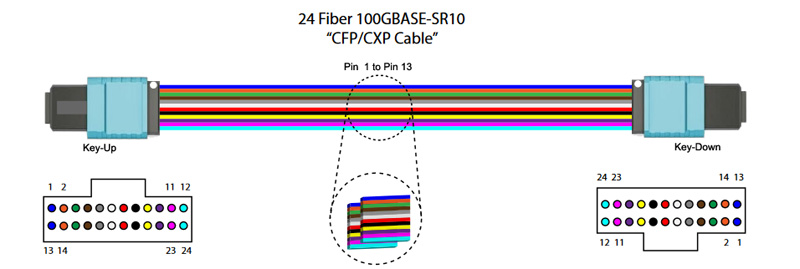
24 Fiber MPO cables are most often used in 100G CFP/CXP applications. Transceivers utilize the inside 10 fibers on each row, with Rx on the top row (2-11) and Tx on the bottom row (14-23). Our cables are built with all 24 fibers for additional use with cassettes or other applications. The key-up to key-down configuration sends the top row to the bottom and vice versa.
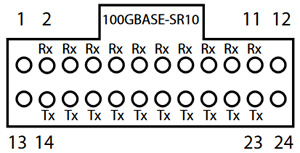
Parameter Reference
| Type | Singlemode (APC Polish) | Singlemode (PC Polish) | Multimode (PC Polish) | |||
| Fiber Count | 8, 12, 24, etc. | 8, 12, 24, etc. | 8, 12, 24, etc. | |||
| Fiber Type | G652D, G657A1 etc. | G652D, G657A1 etc. | OM1, OM2, OM3 etc. | |||
| MaximumInertion Loss | Elite | Standard | Elite | Standard | Elite | Standard |
| Low Loss | Low Loss | Low Loss | ||||
| ≤0.35 dB | ≤0.75 dB | ≤0.35 dB | ≤0.75 dB | ≤0.35 dB | ≤0.60dB | |
| Return Loss | ≥55 dB | ≥45 dB | ≥20 dB | |||
| Durability | ≥200 times | ≥200 times | ≥200 times | |||
| OperatingTemperature | -10℃ ~ +70℃ | -10℃ ~ +70℃ | -10℃ ~ +70℃ | |||
| Test Wavelength | 1310nm | 1310nm | 850nm | |||
Multimode Fiber Variants
While singlemode is optimized for long range data transfer, multimodes are designed with high-bandwidth short range optimization in mind. OM1 is a 62.5/125μm fiber core, with the jacket usually cladded in orange. This is typically found in older applications where high bandwidth isn’t a priority. OM2 is the first variant of 50/125μm, usually also orange, but widely unused. OM2 offers modest improvement over OM1, however OM3 is leaps and bounds ahead with not much more cost. OM3 is a laser optimized variant of 50/125μm multimode, and is the first fiber mode that supports 10Gb/40Gb/100Gb Ethernet. A recent addition to the lineup is OM4, which offers a longer range than OM3. It should be noted that OM3 and OM4 are cross-compatible, and while OM4 is only needed for distances that exceed OM3 capabilities, it can still be used for shorter connections.
| Type | 10 Gb | 40 Gb | 40 Gb (QSFP+ eSR4) | 100 Gb (24 Fiber) |
| OM1 | 33m | N/A | N/A | N/A |
| OM2 | 82m | N/A | N/A | N/A |
| OM3 | 300m | 100m | 330m | 100m |
| OM4 | 400m | 150m | 550m | 150m |





